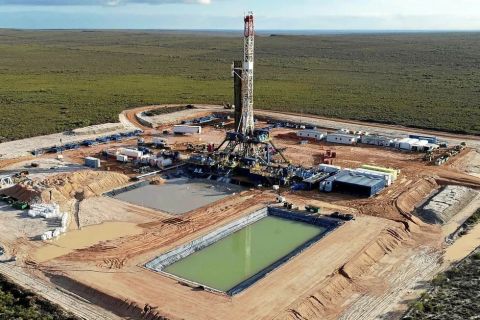OPEC has boosted oil production in October to the highest since 2016, a Reuters survey found, as higher output led by the United Arab Emirates (UAE) and Libya more than offset a cut in Iranian shipments due to U.S. sanctions.
The 15-member OPEC has pumped 33.31 million barrels per day (bbl/d) this month, the survey on Oct. 31 found, up 390,000 bbl/d from September and the highest by OPEC as a group since December 2016.
OPEC agreed in June to pump more oil after pressure from U.S. President Donald Trump to curb rising prices and make up for an expected shortfall in Iranian exports. Oil hit a four-year high of $86.74 a barrel on Oct. 3 but has since eased to $76 as concerns over tight supplies faded.
"Oil producers appear to be successfully offsetting the supply outages from Iran and Venezuela," said Carsten Fritsch, analyst at Commerzbank in Frankfurt.
RELATED: Trump Blasts OPEC As Oil Prices Trade At Highest Since 2014
The June pact involved OPEC, Russia and other non-members returning to 100% compliance with output cuts that began in January 2017, after months of underproduction in Venezuela, Angola and elsewhere had pushed adherence above 160%.
In October, the 12 OPEC members bound by the supply-limiting agreement lowered compliance to 107% as production rose, from a revised 122% in September, the survey found.
This is the closest OPEC has moved to 100% compliance since the June agreement.
UAE, LIBYA
The biggest increase has come this month from the UAE.
Output in October rose by 200,000 bbl/d to 3.25 million bbl/d, the survey found, and could, in theory, rise further as the UAE says its oil-production capacity will reach 3.5 million bbl/d by the year-end.
The second-largest came from Libya where production averaged 1.22 million bbl/d, the survey found, a rise of 170,000 bbl/d. Libyan output remains volatile due to unrest, raising questions about the stability of current OPEC production.
Saudi Arabia, after opening the taps in June and then scaling back its plans to pump more, supplied 10.65 million bbl/d in October, more than in June and close to a record high, the survey found.
The kingdom, OPEC's top producer, has indicated it is concerned about potential oversupply, raising the prospect that its next production adjustment could be to rein in output.
OPEC's second-largest producer, Iraq, also raised output in October.
Iraqi supply could rise further if Iraq's new government goes ahead with a deal reached by the outgoing administration and the Kurdistan Regional Government (KRG) to resume exporting Kirkuk crude to Turkey via the KRG.
Angola, where natural declines at oilfields curbed production in recent years, boosted supply in October due to supply from a new field, Gindungo. Output is still far below its OPEC target.
Supply in Nigeria rose by 30,000 bbl/d. Like Libya, Nigeria is not part of the OPEC supply-cutting pact because it often faces unplanned outages stemming from unrest.
Output in Kuwait edged lower, the survey found. The country had raised production in July following the OPEC deal, and kept it steady in August and September.
Among countries with lower output, the biggest drop—100,000 bbl/d—occurred in Iran. Exports fell as returning U.S. sanctions discouraged companies from buying the country's oil, although the decline was lower than some analysts expected.
"Iran is going to come in above expectations," said an industry source who tracks OPEC output, referring to Iranian supply in October.
Production also slipped further in Venezuela, where a lack of funds for the oil industry because of the country's economic crisis is cutting refinery operations and crude exports.
Despite these decreases, OPEC output in October has risen to the highest since December 2016, the month before the supply-cutting pact took effect, according to Reuters surveys.
Some of the extra oil has come from Congo Republic and Equatorial Guinea, which joined OPEC in 2018 and 2017 respectively.
Before Congo joined, OPEC had an implied production target for 2018 of 32.78 million bbl/d, based on cutbacks detailed in late 2016 and Nigeria and Libya's expectations of 2018 output.
According to the survey, OPEC excluding Congo pumped about 530,000 bbl/d above this implied target in October.
The survey aims to track supply to the market and is based on shipping data provided by external sources, Thomson Reuters flows data and information provided by sources at oil companies, OPEC and consulting firms.
Recommended Reading
Brett: Oil M&A Outlook is Strong, Even With Bifurcation in Valuations
2024-04-18 - Valuations across major basins are experiencing a very divergent bifurcation as value rushes back toward high-quality undeveloped properties.
Marketed: BKV Chelsea 214 Well Package in Marcellus Shale
2024-04-18 - BKV Chelsea has retained EnergyNet for the sale of a 214 non-operated well package in Bradford, Lycoming, Sullivan, Susquehanna, Tioga and Wyoming counties, Pennsylvania.
Triangle Energy, JV Set to Drill in North Perth Basin
2024-04-18 - The Booth-1 prospect is planned to be the first well in the joint venture’s —Triangle Energy, Strike Energy and New Zealand Oil and Gas — upcoming drilling campaign.
PGS, TGS Merger Clears Norwegian Authorities, UK Still Reviewing
2024-04-17 - Energy data companies PGS and TGS said their merger has received approval by Norwegian authorities and remains under review by the U.K. Competition Market Authority.
Energy Systems Group, PacificWest Solutions to Merge
2024-04-17 - Energy Systems Group and PacificWest Solutions are expanding their infrastructure and energy services offerings with the merger of the two companies.




